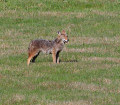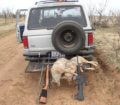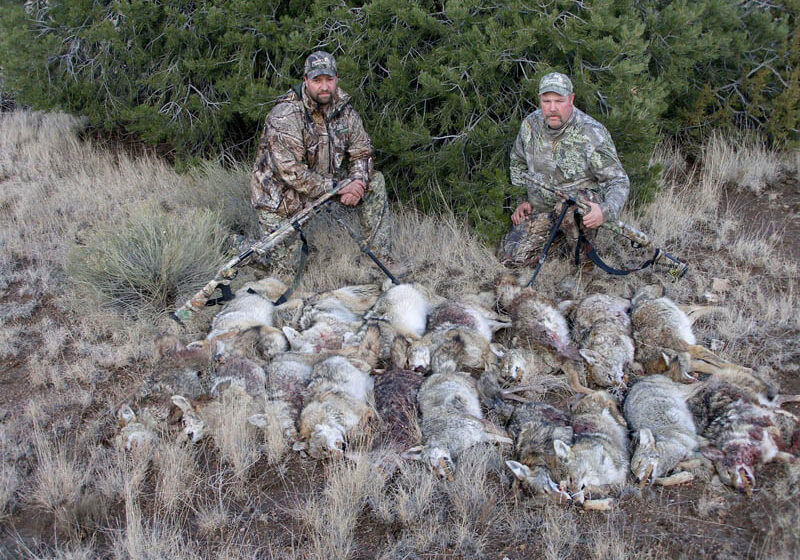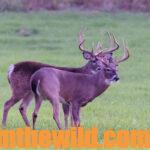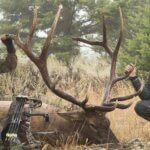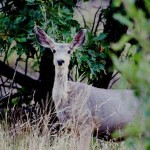Editor’s Note: To improve the habitat and the amount of wildlife on your hunting lands, hunt coyotes, feral hogs, foxes, raccoons, possums and bobcats. The more predators you can remove from the property you hunt between now and deer season, the more you’ll protect wildlife habitat, and the more food your wildlife will have. As Michael Johnson, a predator trapper and hunter from Plainfield, Georgia, explains, “Since I’ve been hunting these predators on my family’s land, we’ve seen a tremendous increase in the number of turkeys. I trap predators too because they’re very-smart animals and often may spook before we can take our shots. Predators are like cockroaches – you can beat their numbers back but never entirely get rid of them.”
 Calling and Setting-Up for Coyotes:
Calling and Setting-Up for Coyotes:
Al Morris of Springville, Utah, is a professional predator hunter. Although Morris primarily hunts in the West, each year he comes to Alabama to hunt coyotes. “If you’ll hunt coyotes and hogs, then they won’t be eating the deer you’re planning to take during deer season,” Morris says. In the South particularly, predators have plenty to eat almost year-round. So, Morris recommends that you use coyote vocalizations to call in coyotes. “Yes, you can call in coyotes using a rabbit-in-distress call,” Morris explains. “However, I prefer using a male coyote howl, a female coyote yodel, the grey fox pup distress call and the coyote pup distress call.”
Morris works for FoxPro (FoxPro https://www.gofoxpro.com), a company that makes some of the nation’s top electronic predator calls. But Morris knows that calling coyotes successfully is much more than just using the right call. Where and how you set-up, and knowing what the coyotes will do, and why they’ll do it, are other important elements of successful hunting. According to Morris, “I’ll set up my FoxPro remote caller about 20 to 30 yards in front of me or on either side of me. I want some kind of lane – a logging road, a woods road or a cleared path – beside me to enable me to see and take the coyotes trying to circle downwind to smell me. When the coyotes start coming to the call, 90 percent of the time they’ll circle downwind of the call before they come in to the call. You’ve got to be able to see the downwind side of where you’ve set-up for calling.”
Learning the Best Equipment and Techniques for Coyotes:
Most predator hunters use two types of guns – a shotgun shooting No. 1 buckshot or a specially-designed predator load or a rifle to take long-distance shots. If you’re trying to call coyotes across a pasture or a clear-cut where you can see a long way, a .22 or a .243 rifle is preferred. But in thick woods like those present in Alabama where I live, more than likely, you’ll have a close shot and will need a shotgun. Morris uses both types of guns and says, “I hold my shotgun, expecting the coyote to come in close. If it does, then I’m ready to shoot. If I see the coyote coming down a power line, across a pasture or running across a fresh clear-cut, I’ll have time to put my shotgun down, pick up my shooting sticks and my rifle and wait for the coyote to stop, so I can take a shot.”
 However, coyotes aren’t always where you think they are. I was hunting coyotes with Tad Brown of Missouri, a predator hunter with Hunter’s Specialties (http://www.hunterspec.com/) and was 20 yards in front of Brown. We were calling into thick cover where Brown felt sure there was a coyote. But, when I cut my eyes to the right, I saw a coyote trying to sneak around behind Brown, and I was able to get off the shot. Another tactic that works well is to put the caller/shooter within 10 to 20 yards of an electronic call. There’s a good chance you’ll call in young coyotes that may come running straight to the call, The second hunter needs to set-up 30 yards behind the first hunter on the downwind side of the call to watch the edge of a woods road, a clear-cut or a pine plantation. He can get a shot at the coyotes that the first hunter doesn’t see.
However, coyotes aren’t always where you think they are. I was hunting coyotes with Tad Brown of Missouri, a predator hunter with Hunter’s Specialties (http://www.hunterspec.com/) and was 20 yards in front of Brown. We were calling into thick cover where Brown felt sure there was a coyote. But, when I cut my eyes to the right, I saw a coyote trying to sneak around behind Brown, and I was able to get off the shot. Another tactic that works well is to put the caller/shooter within 10 to 20 yards of an electronic call. There’s a good chance you’ll call in young coyotes that may come running straight to the call, The second hunter needs to set-up 30 yards behind the first hunter on the downwind side of the call to watch the edge of a woods road, a clear-cut or a pine plantation. He can get a shot at the coyotes that the first hunter doesn’t see.
** Be sure to check your state’s regulations about trapping and hunting predators. **
To learn more about hunting, check out John E. Phillips’ print, Audible and Kindle books at https://johninthewild.com/books/. You also can download a free Kindle app that enables you to read the book on your iPad, computer or SmartPhone.

